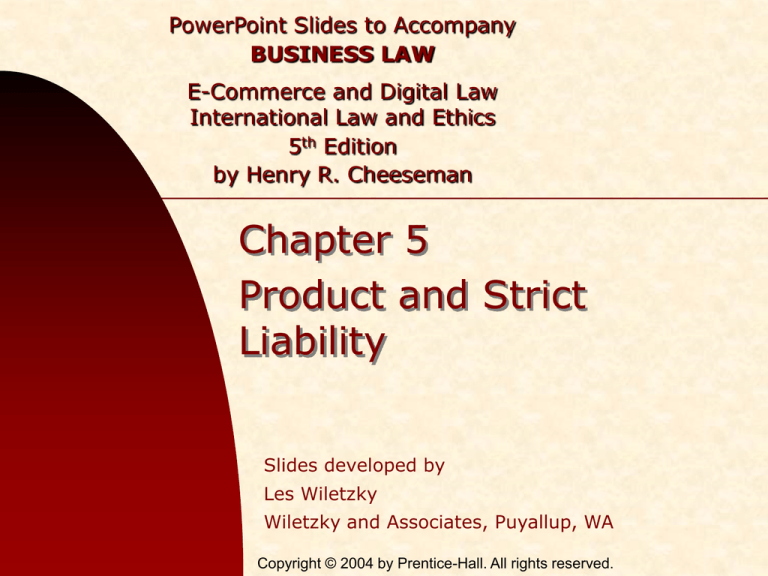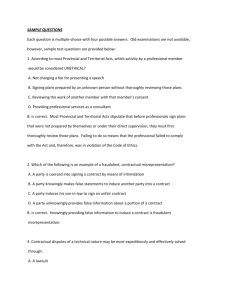
PowerPoint Slides to Accompany
BUSINESS LAW
E-Commerce and Digital Law
International Law and Ethics
5th Edition
by Henry R. Cheeseman
Chapter 5
Product and Strict
Liability
Slides developed by
Les Wiletzky
Wiletzky and Associates, Puyallup, WA
Copyright © 2004 by Prentice-Hall. All rights reserved.
Products Liability
The liability of manufacturers,
sellers, and others for the injuries
caused by defective products.
Copyright © 2004 by Prentice-Hall. All rights reserved.
5-2
Tort Liability Based on Fault
Negligence
Intentional
Misrepresentation
Copyright © 2004 by Prentice-Hall. All rights reserved.
5-3
Tort Liability Based on Fault (continued)
Negligence
A tort related to defective products.
The plaintiff must prove that the defendant
breached a duty of due care to the plaintiff
that caused the plaintiff’s injuries.
In a negligence lawsuit, only a party who was
actually negligent is liable to the plaintiff.
Copyright © 2004 by Prentice-Hall. All rights reserved.
5-4
Landmark Law
In MacPherson v. Buick Motor Co., the
court held that an injured consumer could
recover damages from the manufacturer of
the product even though he or she was only
in privity of contract with the retailer from
whom he or she had purchased the product.
Copyright © 2004 by Prentice-Hall. All rights reserved.
5-5
Tort Liability Based on Fault (continued)
Negligence (continued)
Failure to exercise due care includes:
Failing to assemble the product carefully.
Negligent product design.
Negligent inspection or testing of the product.
Negligent packaging.
Failure to warn of the dangerous propensities
of the product.
Copyright © 2004 by Prentice-Hall. All rights reserved.
5-6
Tort Liability Based on Fault (continued)
Intentional Misrepresentation
When a seller or lessor (1) fraudulently
misrepresents the quality of a product, or (2)
conceals a defect in it, and a buyer is injured
thereby.
Copyright © 2004 by Prentice-Hall. All rights reserved.
5-7
The Doctrine of Strict Liability
In Greenmun v. Yuba Power Products,
Inc., the California Supreme Court adopted
the doctrine of strict liability in tort as a
basis for product liability actions.
Copyright © 2004 by Prentice-Hall. All rights reserved.
5-8
The Doctrine of Strict Liability (continued)
Liability Without Fault
Unlike negligence, strict liability does not
require the injured person to prove that the
defendant breached a duty of care.
Strict liability is imposed irrespective of fault
on manufacturers, sellers, and lessors who
make and distribute defective products that
cause injury to users and others.
Copyright © 2004 by Prentice-Hall. All rights reserved.
5-9
The Doctrine of Strict Liability (continued)
Chain of Distribution
All parties in the chain of distribution of a
defective product are strictly liable for the
injuries caused by that product.
All manufacturers, distributors, wholesalers,
retailers, lessors, and subcomponent
manufacturers may be sued under this
doctrine. (doctrine of strict liability in tort)
Copyright © 2004 by Prentice-Hall. All rights reserved.
5 - 10
The Doctrine of Strict Liability (continued)
Privity of contract is not required for a plaintiff
to sue for strict liability.
The doctrine applies even if the injured party
had no contractual relations with the
defendant.
The damages recoverable in a strict liability
action vary by jurisdiction.
Copyright © 2004 by Prentice-Hall. All rights reserved.
5 - 11
The Doctrine of Strict Liability (continued)
Punitive damages are often awarded in strict
liability lawsuits if the plaintiff proves that the
defendant either:
Intentionally injured him or her; or
Acted with reckless disregard for his or her
safety.
Copyright © 2004 by Prentice-Hall. All rights reserved.
5 - 12
Doctrines of Negligence and Strict Liability Compared
Defendant
Manufacturer
(negligent)
Defendant
Defective product
Distributor
Defendant
All in the chain of
distribution are
liable
Negligent party is
liable
Retailer
Negligence
lawsuit
Consumer
Defendant
Strict liability
lawsuit
Defective product causes injury
Copyright © 2004 by Prentice-Hall. All rights reserved.
5 - 13
The Concept of Defect
To recover for strict liability, the injured party
must first show that the product that caused
the injury was somehow defective.
Plaintiffs can allege multiple product defects
in one lawsuit.
Copyright © 2004 by Prentice-Hall. All rights reserved.
5 - 14
The Concept of Defect (continued)
Manufacture
Failure to Warn
Design
The most
common types
of defects:
Copyright © 2004 by Prentice-Hall. All rights reserved.
Packaging
5 - 15
The Concept of Defect (continued)
Defect in Manufacture – a defect that
occurs when the manufacturer fails to:
1. Properly assemble a product
2. Properly test a product, or
3. Adequately check the quality of a product
Copyright © 2004 by Prentice-Hall. All rights reserved.
5 - 16
The Concept of Defect (continued)
Defect in Design – a defect that occurs
when a product is improperly designed.
Design defects include:
1. Toys designed with removable parts that
could be swallowed by children.
2. Machines and appliances designed without
proper safeguards.
3. Trucks designed without a backup warning
device.
Copyright © 2004 by Prentice-Hall. All rights reserved.
5 - 17
The Concept of Defect (continued)
Defect in Design (continued)
In evaluating the adequacy of a product’s
design, the courts apply a risk-utility analysis
and consider the:
Gravity of the danger posed by the design
Likelihood that injury will occur
Availability and cost of producing a safer design
Social utility of the product
Copyright © 2004 by Prentice-Hall. All rights reserved.
5 - 18
Crashworthiness Doctrine
The courts have held that automobile
manufacturers are under a duty to design
automobiles so they take into account the
possibility of harm from a person’s body
striking something inside the automobile in
the case of a car accident.
Copyright © 2004 by Prentice-Hall. All rights reserved.
5 - 19
The Concept of Defect (continued)
Defect in Packaging – a defect that occurs
when a product has been placed in
packaging that is insufficiently tamperproof.
Manufacturers owe a duty to design and
provide safe packages for their products.
Failure to meet this duty subjects the
manufacturer and others in the chain of
distribution of the product to strict liability.
Copyright © 2004 by Prentice-Hall. All rights reserved.
5 - 20
The Concept of Defect (continued)
Failure to Warn – a defect that occurs when
a manufacturer does not place a warning on
the packaging of products that could cause
injury if the danger is unknown.
Copyright © 2004 by Prentice-Hall. All rights reserved.
5 - 21
The Concept of Defect (continued)
Other Product Defects
Failure to provide adequate instructions
Inadequate testing of products
Inadequate selection of component parts or
materials
Improper certification of the safety of a
product
Copyright © 2004 by Prentice-Hall. All rights reserved.
5 - 22
Supervening
Event
Defenses to
Product
Liability
Contributory &
Comparative
Negligence
Generally
Known Dangers
Assumption of
the Risk
Government
Contractor
Defense
Misuse of the
Product
Statute of
Limitations
Copyright © 2004 by Prentice-Hall. All rights reserved.
5 - 23
Defenses to Product Liability (continued)
Supervening Event – an alteration or
modification of a product by a party in the
chain of distribution that absolves all prior
sellers from strict liability.
Copyright © 2004 by Prentice-Hall. All rights reserved.
5 - 24
Defenses to Product Liability (continued)
Generally Known Dangers – a defense that
acknowledges that certain products are
inherently dangerous and are known to the
general population to be so.
Sellers are not strictly liable for failing to warn
of generally known dangers.
Copyright © 2004 by Prentice-Hall. All rights reserved.
5 - 25
Defenses to Product Liability (continued)
Government Contractor Defense – a
defense that says a contractor who was
provided specifications by the government is
not liable for any defect in the product that
occurs as a result of those specifications.
Copyright © 2004 by Prentice-Hall. All rights reserved.
5 - 26
Defenses to Product Liability (continued)
Assumption of Risk – a defense in which
the defendant must prove that:
1. The plaintiff knew and appreciated the risk,
and
2. The plaintiff voluntarily assumed the risk.
Copyright © 2004 by Prentice-Hall. All rights reserved.
5 - 27
Defenses to Product Liability (continued)
Misuse of the Product – a defense that
relieves the seller of product liability if the
user abnormally misused the product.
Products must be designed to protect against
foreseeable misuse.
Copyright © 2004 by Prentice-Hall. All rights reserved.
5 - 28
Defenses to Product Liability (continued)
Statute of Limitations and Statute of
Repose
Statute of Limitations: a statute that
requires an injured person to bring an action
within a certain number of years from the time
that he or she was injured by the defective
product.
Copyright © 2004 by Prentice-Hall. All rights reserved.
5 - 29
Defenses to Product Liability (continued)
Statute of Limitations and Statute of
Repose (continued)
Statute of Repose: a statute that limits the
seller’s ability to a certain number of years
from the date when the product was first sold.
Copyright © 2004 by Prentice-Hall. All rights reserved.
5 - 30
Defenses to Product Liability (continued)
Contributory and Comparative Negligence
Contributory Negligence: a defense that
says a person who is injured by a defective
product but has been negligent and has
contributed to his or her own injuries, cannot
recover from the defendant.
Copyright © 2004 by Prentice-Hall. All rights reserved.
5 - 31
Defenses to Product Liability (continued)
Contributory and Comparative Negligence
(continued)
Comparative Negligence: a doctrine that
applies to strict liability actions that says a
plaintiff who is contributorily negligent for his
or her injuries is responsible for a proportional
share of the damages.
Copyright © 2004 by Prentice-Hall. All rights reserved.
5 - 32
International Law:
Product Liability in Japan
Product liability claims are rare in Japan for
several reasons:
1. The plaintiff has the difficult burden of
proving that the company was negligent
2. Japanese courts do not allow discovery
3. Claimants must pay a percentage of any
damages requested (not won) as court fees
Copyright © 2004 by Prentice-Hall. All rights reserved.
5 - 33
International Law:
Product Liability in Japan (continued)
4. Awards granted by courts are small (by
U.S. standards)
5. Punitive damages are not available
Copyright © 2004 by Prentice-Hall. All rights reserved.
5 - 34








